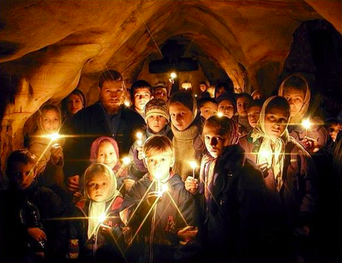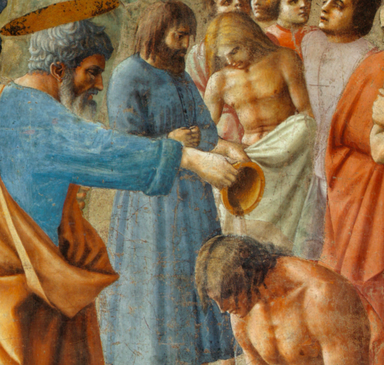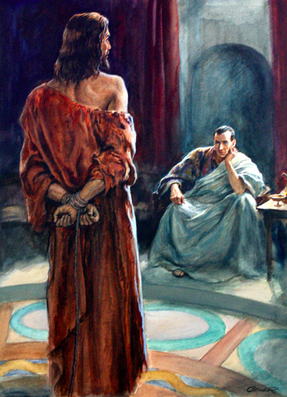 Some quotes of importance from my reading this morning. As we approach Easter, we reminisce the empty tomb, and rightly so, but we should also reimagine that the local church is the reality of the resurrection . . . the gathered church in a local place, in the flesh of the community, are sites of the resurrection presence of Jesus in the here and now. Yet, the way in which a church demonstrates the power of the resurrection is by living out a cruciformed (cross-oriented) life among its congregation and in the midst of the community that surrounds it. The quotes: “. . . these [church] communities gathered as sites of resurrection presence.” “Resurrection presence can only be enjoyed and inhabited by grace through cruciform postures of self-giving love, service, and celebration.” “. . . resurrection presence is encountered wherever people gather in the name of Jesus and adopt a cruciform identity.” “It is no less countercultural in our day where a variety of pressures force churches to attract increasing numbers of people by appealing to cultural desires that are subtly shaped by the present evil age . . . The redeeming presence of heaven is brought to earth in cruciform communities, transforming our imaginations so that we see the world as God sees it. It is not a world of limited goods where we all must hoard and protect our stuff and pursue our own selfish desires.” “Churches enjoy the superabundant realities of heaven by enacting cross-oriented community behaviors that we find throughout the Gospels and Paul’s letters: confession of sin and forgiveness, service to one another, self-giving love embodied through meeting one another’s needs and offering hospitality to one another—especially to those on the margins of our communities.” ~Timothy Gombis, Power in Weakness: Paul's Transformed Vision for Ministry (p. 52–54)
0 Comments
 II. This scene tells us we serve another king and is the gospel to us, the church The second of our Pilate-questions comes to us in v. 33, “Are you the King of the Jews?, and suggests that Jesus is no ordinary accused. This question sets us (the listeners of the story) up to realize we belong to another kingdom and serve another kind of king, that our belief and church habits should affirm this in our gathering and in our discipleship, in how we do church. As Paul pulled from an early liturgy in Phil 2 (And being found in human form, he humbled himself by becoming obedient to the point of death, even death on a cross, 8) and certainly his the “Lord Jesus, on the night he was betrayed” (1 Cor 11:23), the church early on began to remember the events associated with what we call Passion Week. Some of the earliest Christian art portrayed the scenes in this episode of Jesus before Pilate, an indication of their importance in the habit and devotional life of the early church . . . “that which we have seen with our eyes and our hands have handled,” later John tells us—and then we have the creedal, “He suffered under Pontius Pilate.” God died–not in legend, not symbolically, not in a distant past, not in some mysterious realm. The gospel story is brought down to earth and made a part of the life of the church, a part of the life of a gathered-church. Each Sunday Christians everywhere make as part of their confession two names: Mary and Pontius Pilate. Mary’s name as part of Christian creeds is no surprise, but something should jar us about the inclusion of Pilate into the church’s liturgical memory. Karl Barth once said that running into Pilate’s name in creedal recitation was akin to the movement of “a dog into a nice room.” This scene in John’s Gospel has been etched into the memory and habits of the church for centuries. We hear it in the Apostles Creed:
What I find interesting is that the Pilate-Jesus scenes are a part of early household baptisms. Before we moved from gathered-household churches scattered across the empire to Caesar-sanctioned buildings, we have an account of a baptismal service from Hippolytus of Rome (about 200 AD): The candidate to be baptized would be asked: “Do you believe in God, the Father Almighty?” The baptismal candidate was to say: “I believe.” Then just as the rite of baptism took place, the one being baptized was asked: “Do you believe in Christ Jesus, the Son of God, who was born of the Virgin Mary, and was [wait for it . . .] crucified under Pontius Pilate . . .” Christians began their life of faith with a confessional connection to Pontius Pilate. Later in the Nicean Creed, about 325 AD we read (we recite), “For us and for our salvation he came down from heaven . . . For our sake he was crucified under Pontius Pilate.” For our sake . . . the initiation and weekly confession of our faith was linked to . . . Pilate and Jesus We don’t know much about Pilate. We know that he was a Roman prefect over Judea and we know that he was married. Dorothy Sayers wrote: the importance of Christ before Pilate is that we no longer behold God-in-his-thusness, as transcendent, abstract, and universal, but rather God-in-his-thisness, as embodied in the person of Jesus, as immanent, concrete, now encountered as triune. Indeed, we are face-to-face with the shocking particularity of the Christian faith, made more scandalous by God’s weakness and poverty in the person of Jesus. Sayers reminds us that the threats of those in power mean nothing to those prepared to die, to those who know that dying and suffering is not the worst thing we do as human beings. The truth rests with those who, in humility, are not afraid because they know what is beyond this life–they know a different king and belong to a different kingdom. In this confrontation between Jesus and Pilate, the battle between the powers of this world and divine power comes to a pen-ultimate climax, with Jesus acknowledging Pilate’s limited culpability when Christ tells him “You would have no power over me unless it had been given you from above.” Pilate’s question in 18:39, ‘What is truth,’ exposes the perplexity of a person who is a stranger to himself, uncomprehending and confused, so very short of the freedom proper to human life (Sayers). But this is the same space the church occupies amid outsiders, for we know the truth. There is narrative parallel here between Jesus’ kingly authority and the mention of truth. In his Gospel, John closely webs Jesus’ presence and authority to the concept of truth:
And in our scene this morning (v. 37): “. . . for this purpose (Jesus says to Pilate) I have come into the world—to bear witness to the truth. Everyone who is of the truth listens to my voice.” It is here that the Accused calls his judge to repentance and to choose what does not appear to be the case in that judgement hall. Jesus opens a path to faith for Pilate to believe Jesus is a king and has kingly authority: choose Christ or choose Caesar. The One in the dock (the old English word for the place of the accused in a courtroom) invites his judge to be his follower, to align himself with those who are “of the truth,” to deny Caesar. In this Jesus is very dangerous to all who have power. Isn’t this our calling? Isn’t this the church, a local gathered-church, set at the end of accusation . . . calling our accusers (the skeptical, the unbeliever, those that misunderstand us, those that judge us fools and foolish) to join us, to deny Caesar and all the powers aligned against God and to follow the One who went to a cross because that is the only way for life to happen, the only path of resistance to the powers of this world.
Isn’t this the sphere and place of church: we confront our accusers (outsiders on that wide range of skeptics to haters) in our worship and in our mixed gathering of unequal strangers with the presence of Christ, to create an opportune space to acknowledge Jesus as king? The tables are turned in a gathered-church. It is our very presence, it is the witness of the very presence of the church, as it stands before Pilate if you will, before our neighbors, family, and friends, that opens the choice: choose Caesar or choose Christ . . . And for us, right here, right now: If Jesus’ claims are to be believed and investment in the church is to be had, despite social, political, religious, and familia pressures to abandon or compromise, then the nature of Jesus’ authority, the nature of his kingship need to be clear—at the most critical moment, right here before Pilate (when life or death is the apparent choice) it is made very clear. This claim, the fledgling, persecuted, maligned, powerless church needed to hear, just as we do as a gathered-church right here: Life nor salvation would not be found in the temples that Caesar used to maintain his control over his empire; but, in the One standing before Caesar’s proxy—life and salvation is only found in the One who suffered under Pontus Pilate. Even this awful scene, despite all appearances, is gospel especially to a gathered- church.
 Harriet Beecher Stowe’s Uncle Tom’s Cabin is one the most influential novels in American history. I betcha didn’t know it has a subtitle: Or, Life Among the Lowly. Released in 1852, second best-selling book of that century only to the Bible. Uncle Tom’s Cabin depicted the reality of slavery, and, to some, helped to lay “the groundwork for the Civil War”[1] A southerner reported saying that this novel “had given birth to a horror against slavery in the Northern mind which all the politicians could never have created” (David S. Reynolds). Even Abraham Lincoln, upon meeting Harriet Stowe, famously said, Is this the little woman who made this great war? I love to tell stories. My daughter says, “Dad, you have a story for everything.” She didn’t say I had lots of stories, but for everything I had a story. Stories are for the hearer—they do something for those who listen. Just like Uncle Tom’s Cabin had unleashed “this great war” to help end slavery, so the Gospels are for changing us, motivating us, the gathered-church . . . no wonder God created the “Gospels” to immortalize His story to his gathered-churches. I’m persuaded the Gospel of John was written in Ephesus and its audience was the household churches throughout western Asia Minor. These house gathered-churches were filled with believers who had had a very cultural, pagan temple-life, centered around the Roman empire, the Caesar-cult, and multiple deities, regional, local, and even household amulets; and, who celebrated this life at regular “suppers” of gathered guests and peers (known as diapnon). I know Pastor Andrew has drawn out the temple themes in John’s Gospel—and this should be no surprise, for as the gospel had so disturbingly penetrated the Gentile world and now . . . believing Gentiles and households of worshipping believers needed to learn a different temple-life. One that looked and felt more like a living room filled with unequal strangers . . . one that was treasonous to Caesar and the empire rather than one socially and culturally safe and approved by Caesar—or, like now, safe in a Christianized culture. What would this episode in John 18-19 mean to those young household churches of mostly former (and some, for sure, still) temple-worshipping Gentiles; of families empire-dependent and encultured by pagan temple-life? In some way, this switch from going to temple and living a temple-habit life, in and out of one’s home, has some bearing on how we are to hear this epic set of scenes in John’s Gospel of Jesus before Pilate. The question before us in this episode isn’t just historical (e.g., nice things to know about Jesus), but how does it speak to us as church? Not insights for our privatized Christian lives, but a story for church, a gathered-church, for Christ Presbyterian Church Fairfield or Christ Presbyterian Church in The Hill. As with any story, we should ask with whom do we identify? We’d be splitting hairs over identifying with the Jewish leaders or the crowd or with Pilate. Let’s not say Jesus . . . not this time. As with the nature and purpose of the Gospels, I say, it is the readers with whom we are to identify: what does this text mean for those early Christians and what is its significance to us, the gathered-church right here, right now? There are lots of questions Pilate asks throughout this scene. John harnesses them as platforms for the listening gathered-church to hear and respond themselves to this story . . . there are three questions in particular that help us through this scene so we may respond as church. I. This scene orients us toward fulfillment—it calls the church to have patient-trust in God’s fully capable providence The first of our Pilate-questions comes at the scene’s beginning, verse 20: “What accusation do you bring against this man?” Though Pilate is asking the Jewish leaders to determine if Jesus should be before him in the first place, this question sets up the listener to learn that Jesus, despite all appearances, was before Pilate because God had put him there. John records for us in 18:31-32 Pilate said to them, “Take him yourselves and judge him by your own law.” The Jews said to him, “It is not lawful for us to put anyone to death.” This was to fulfill the word that Jesus had spoken to show by what kind of death he was going to die. Later, in 19:10-11, after the Jews challenged Pilate’s authority, which made him fear, we hear Pilate demand of Jesus: “You will not speak to me? Do you not know that I have authority to release you and authority to crucify you?” Jesus answered him, “You would have no authority over me at all unless it had been given you from above . . .” In this, we should detect the plan of God. Jesus is right where God put him. The opening scene links the Jewish temple-leadership and the Roman imperial power together (18:28–32). After Jesus’ arrest, he is led from the house of Caiaphas, who was High Priest, to the governor’s headquarters to get Pilate to exam him. Although Pilate was a weak regent for Caesar in Judea, with him there, Caesar was there in that judgment hall nonetheless. And, despite appearances, the presence of Jesus was confronting temples and temple-powers. Yet, we should also note well the hypocrisy of the temple-leadership exposed here: “. . . They themselves did not enter the governor’s headquarters, so that they would not be defiled, but could eat the Passover” (v. 28) They are willing to use the power of Caesar to do their dirty work in doing away with this troublemaker to their own established authority. Yet they didn’t want to touch the heathen plot of ground—they didn’t want to appear polluted, contaminated and so be denied the Passover. This is significant in that they knew full well that turning Jesus over to Pilate and in short order making it all about Caesar’s authority was to condemn Jesus to crucifixion. The irony: manipulating the political system to kill off the true Passover—1 Cor 5:7, Christ our Passover has been sacrificed. Here, too, we should detect the plan of God.
The first Christian book to be penned by an early church leader, the very first, do you know what the subject was? Tertullian penned Of Patience about 207AD. But when the Lord says this about the flesh, pronouncing it “weak,” He shows what need there is of strengthening, it—that is by patience—to meet every preparation for subverting or punishing faith; that it may bear with all constancy stripes, fire, cross, beasts, sword; all which prophets and apostles, by enduring, conquered! (Chapter XIII) A second general Christian volume comes to us from Cyprian of Carthage at about 257 AD. Guess it’s subject? The Advantage of Patience. What is so fascinating is that Cyprian linked patience to that scene in John’s Gospel of Jesus and Pilate: Surely, He who was not rebellious, neither contradicted, when He offered His back to stripes, and His cheeks to the palms of the hands; neither turned away His face from the foulness of spitting. Surely it is He who, when He was accused by the priests and elders, answered nothing, and, to the wonder of Pilate, kept a most patient silence. . . (No. 23) This is the first thing: As a church we need, despite all appearances, to have a patience-trust in God’s providence. Imagine the trust and patience that they needed . . . no leverage, no power, disconnected from everything that gave life meaning (no temple, no protection from honoring Caesar, no affirming the tiers of human-hierarchy that sustained the life of the empire), nothing but their fellowship of unequal strangers, somewhat unlawfully meeting in someone’s home . . . Jesus standing there at the end of Pilate’s (really Caesar’s) judgment . . . we, too, must have such patient-trust that we are right where God has put us as a church
|
AuthorChip M. Anderson, advocate for biblical social action; pastor of an urban church plant in the Hill neighborhood of New Haven, CT; husband, father, author, former Greek & NT professor; and, 19 years involved with social action. Archives
February 2024
Categories
All
|
Pages |
More Pages |
|
 RSS Feed
RSS Feed